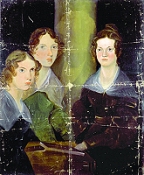|
|
|
|
HIDDEN BELLS When the novels of Currer, Ellis and Acton Bell were published in the late 1840s, their wild, passionate, sometimes violent content, caused a sensation. Public opinion was divided. Some critics described them as "brutal", "coarse" and "wicked", but the appetite of the reading public to obtain books written by the Bell brothers was insatiable. Then there was the added mystery of the identity of the authors. Thomas Newby, who had published Emily's Wuthering Heights and Anne's Agnes Grey, seeing the success of Jane Eyre, published by Smith, Elder & Co. and wishing to benefit from the latter's success, claimed the novels were written by the same author. When he published Anne's second novel The Tenant Of Wildfell Hall in 1848, it was advertised as the latest work by Currer Bell. The three sisters were left with little choice but to reveal their true identities. Emily, preferring anonymity, refused to accompany Charlotte and Anne to the offices of Smith, Elder & Co. in London. One can only imagine the surprise of publisher George Smith when confronted by two quaintly dressed young women claiming to be the brothers Bell! Success for the sisters was but a brief episode in their short lives. The shadow of death lingered over them all. Losing their mother and two older sisters when they were very young played a pivotal role in their tales of orphans, spirits and hauntings. As children, they grew deeply attached to their parsonage home and its close proximity to the moors circling the village of Haworth. In adulthood it provided them with sanctuary when homesickness and adversity overwhelmed them. A set of soldiers given to brother Branwell were given identities and existed in imaginary worlds invented by the children. Christened 'The Young Men', they inhabited an empire known as 'Glasstown'. Branwell and Charlotte later developed the East African province of 'Angria'. Emily and Anne created 'Gondal', a large island in the North Pacific. Their tales of love affairs, political intrigue and bloody battles, were assiduously recorded in miniature handmade books and dominated their thoughts well beyond childhood, sowing the seeds for the novels to come. |
|
|
||
 Patrick
Brontё, born in Emdale, County Down, Ireland in 1777
won a scholarship to Cambridge University and graduated
as a Bachelor of Arts in Divinity in 1806. Patrick
Brontё, born in Emdale, County Down, Ireland in 1777
won a scholarship to Cambridge University and graduated
as a Bachelor of Arts in Divinity in 1806.After various posts as curate in Wethersfield in Essex, Wellington in Shropshire and Dewsbury Minster in Yorkshire, he secured his first ministerial position in nearby Hartshead. Around this time he met the bright and talented Maria Branwell, the niece of a friend, who was on a visit from Penzance. They married in 1812 and settled in Yorkshire. Their first two daughters, Maria and Elizabeth were born whilst at Hartshead. Charlotte, Branwell, Emily and Anne were born in the parsonage at Thornton, before the family moved to their final home in Haworth, where Patrick remained as minister for the rest of his life. Maria, tragically died from cancer within the year of arriving in Haworth. A servant heard her cry, "Oh God, my poor children!" The youngest, Anne, was less than a year old. Patrick reared his children with the help of his late wife's sister, but anxious to provide them with a mother, proposed marriage to various ladies known to him. A widower with six children would not have been an attractive proposition. They turned him down! |
|
|
|
|





